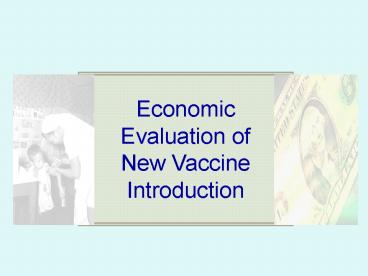Economic Evaluation of New Vaccine Introduction - PowerPoint PPT Presentation
1 / 18
Title:
Economic Evaluation of New Vaccine Introduction
Description:
Increase divergences in vaccination schedule between developed and developing countries; ... Guyana provides MMR vaccine instead of measles. ... – PowerPoint PPT presentation
Number of Views:120
Avg rating:3.0/5.0
Title: Economic Evaluation of New Vaccine Introduction
1
Economic Evaluation of New Vaccine Introduction
2
Fact
- In recent years the vaccine and immunization
financing have broadened due to - Increase divergences in vaccination schedule
between developed and developing countries - Increase diversity of products and available to
countries - Emergence of developing country manufacturers
- Importance of new global initiatives such as GAVI.
3
Global Trends
- Countries and partners are increasingly concerned
about costs and financing - Complex picture lack of resources, financial
management, absorptive capacity - More reliable information is now available on
immunization financing based on FSP submitted by
countries 2 rounds, more coming this year..
4
Vaccine Presentation in selected Hib countries
5
Cost per DTP3 child in a sample of Hib
introducing countries
() Guyana provides MMR vaccine instead of
measles.
6
GAVI Achievements
- Countries supported through GAVI are required to
develop financial sustainability plans (FSPs) - The first round of FSPs have provided new
information about the challenges of financing new
vaccines in poor countries
7
FSP Analysis
- A quick look at
- Cost implication of VF supported new vaccine
introduction - Some financing and sustainability issues
- Methodological points
- Based on 2002 and 2003 FSP data - 24 countries
- Focused on routine services
- Immunization specific costs
- Two snap-shot years
- Generalizations are difficult
- Findings are very preliminary!
8
Cost Implication of NVI (24)
120
Vaccines and injection supplies are becoming the
main cost drivers of programs
108 million
13
100
50
80
26
68 million
Vaccines (basic 6 antigens)
Vaccines (new underused)
60
11
Injection Supplies
11
Personnel
40
Other Recurrent Costs ()
22
Vehicles, Cold Chain and
other Equipment
20
13
Slight reduction in spending on basic vaccines
(DTP now the platform of new vaccines)
-
Pre-Vaccine Fund Year
Year with Vaccine Fund
(Baseline)
Support (VF Year)
()
Other recurrent program specific costs include
spending on tranportation
(
fuel
)
,
cold chain maintenance
and building overhead, training, social
mobilization and disease surveillance.
9
Cost Per DTP3 Child With Hib
15
4
2
DTP-HepB-Hib at different rates of introduction
10
Cost Per DTP3 Child With Hep B
Wide variability in costs across countries
Different rates of introduction make comparisons
difficult
11
Non-Vaccine/Delivery Costs
Overall increase in total non-vaccine costs of
26 (24)
Not clear how much of the increase relates to the
introduction of new vaccines
32 of this increases is financed using ISS funds
12
A Look At Financing (24)
120
Vaccine Fund resources are additive
108 million
100
29
80
Other (NGO, foundations...)
68 million
GAVI-Vaccine Fund
11
60
Development Bank
Multilaterals
13
Bilaterals
40
Pooled Funds
Government
37
20
51
Governments are increasing their support for
routine immunization
-
Pre-Vaccine Fund Year
Year with Vaccine Fund Support
(Baseline)
(VF Year)
() Multilaterals are mainly UNICEF and WHO
13
Government Financing
Wide variability in government funding for
routine immunization across countries
The challenge of financial sustainability will be
greater for those that are donor dependant
Pre-Vaccine Fund baseline year
14
Financing of Basic Vaccines
Some countries do not pay for basic vaccines
Financing new vaccines will be a challenge
Picture changes quite dramatically when Vaccine
Fund support is included
Pre-Vaccine Fund baseline year
15
Summary of Findings
- Costs
- Overall rise in immunization costs after NVI
(about 40) - Vaccines are becoming the largest cost driver
- Important rise in the cost of injection supplies
with AD syringes and safety boxes (almost as much
as traditional vaccines) - Wide country variability in cost per DTP3 child.
For the most part lt 20 - Important cost implications of Hib
- Significant rise in non-vaccine costs. Some of it
due to ISS funds - Financing Sustainability
- Increase in spending even if Vaccine Fund support
is excluded (governments have increased their
support) - Wide variability in government funding for
immunization across countries - Some countries do not pay for basic vaccines
16
Sustainability Implications
- The recurrent cost burden of programs is
increasing countries will be more vulnerable to
annual fluctuations in funding - Some countries are not financing basic inputs
- The challenge of financial sustainability will be
greater for countries that are donor dependant
more resources need to be mobilized from outside
sources - Sustaining the increasing costs of programs to
meet program objectives will be a challenge (new
vaccines, non-vaccine costs, campaigns.) - Facing the challenge is a question of priority
setting and firm commitments from governments and
partners to support immunization
17
Challenges
Finance Reduce the financial barriers, to allow
everyone to access existing, new and future
vaccines
Advocacy Ensure that both governments and
international development partners adopt policies
and take actions to stable and adequate financing
for vaccine and immunization
18
FSP for New Vaccine Introduction
- A long-term FSP should be submitted for the
introduction of costly vaccines such as Hep B and
Hib, in the immunization programmes in low-income
countries - Experience shows immunization programme-specific
costs sometimes trebling with the introduction of
Hib containing vaccines in combination form such
as the pentavalent
19
Joint Efforts
- For countries that have already introduced Hib
vaccination, fostering joint efforts between
national authorities, donors, vaccine
manufacturers and technical agencies is required
to help alleviate Hib-containing vaccines
financial challenge - In the field of vaccine financing, pursuing the
efforts of systematic assessment of national
immunization programmes will likely provide
extremely valuable insights































